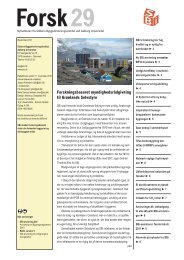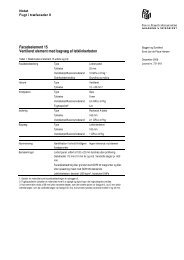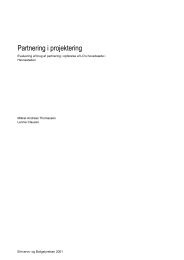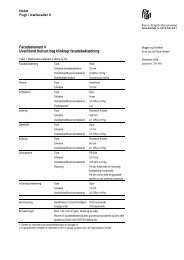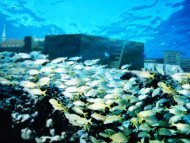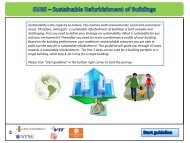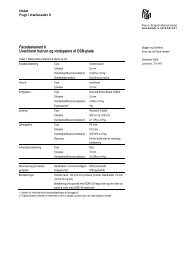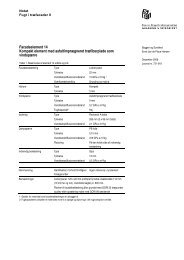Mould growth on building materials - Statens Byggeforskningsinstitut
Mould growth on building materials - Statens Byggeforskningsinstitut
Mould growth on building materials - Statens Byggeforskningsinstitut
You also want an ePaper? Increase the reach of your titles
YUMPU automatically turns print PDFs into web optimized ePapers that Google loves.
ing over some time) recovered from the lung. The bedroom of the child was heavily infested<br />
with S. chartarum and air samples revealed 6×10 4 CFU/m 3 of the fungus.<br />
From St. Louis there is also a report 27 <strong>on</strong> a case of IPH in an infant, who was exposed to<br />
fungi during a 2 weeks holiday. On the return trip the infant developed the hemorrhage up<strong>on</strong><br />
exposure to tobacco smoke. Low quantities of hemosiderin in macrophages in the lung indicated<br />
no preceding bleedings. During the vacati<strong>on</strong> (14 days) the infant had resided in a room<br />
with visible mould <str<strong>on</strong>g>growth</str<strong>on</strong>g> of Trichoderma, Penicillium, Cladosporium and Ulocladium.<br />
Recently a fatal IPH case has been discovered in Belgium (N. Nolard, pers<strong>on</strong>al communicati<strong>on</strong>),<br />
in this case airborne spores were detected, they were released in high numbers due to<br />
c<strong>on</strong>structi<strong>on</strong>al work in the bathroom.<br />
2.4 Biologically active metabolites from moulds<br />
Microfungi have the ability to produce a high number of sec<strong>on</strong>dary metabolites, which they<br />
for various reas<strong>on</strong>s need in their natural habitat 169,170 . Most of these are produced as a resp<strong>on</strong>se<br />
to other organisms especially other fungi 171 . Some of these metabolites can cause a<br />
toxic resp<strong>on</strong>se "when introduced by a natural route in low c<strong>on</strong>centrati<strong>on</strong>s to higher vertebrates<br />
and animals" and are referred to as mycotoxins 172 .<br />
Sorens<strong>on</strong> 173 and Miller 69 were some of the first to realise the implicati<strong>on</strong>s of mycotoxins in the<br />
indoor envir<strong>on</strong>ment. The latter emphasises that moulds generally produce several mycotoxins<br />
and synergizers, which are not toxic themselves, but enhance the toxicity of some mycotoxins<br />
174 . It is also stressed that repeated low c<strong>on</strong>centrati<strong>on</strong> exposure of airborne mycotoxins<br />
would be very difficult to diagnose.<br />
When trying to predict which biologically active compounds of microfungal origin may be present<br />
in water-damaged <strong>building</strong>s - at least five problems have to be addressed:<br />
• Most sec<strong>on</strong>dary metabolites and mycotoxins are species specific making identificati<strong>on</strong> of<br />
isolates to the species level extremely important. Changes in tax<strong>on</strong>omy including introducti<strong>on</strong><br />
of new species and syn<strong>on</strong>omisati<strong>on</strong> of others have further complicated this<br />
work 62,175 .<br />
• False positive findings of mycotoxins are often comm<strong>on</strong> from laboratories which use insufficiently<br />
specific methods, or which are not experienced in mycotoxin analysis and the<br />
large number of interfering compounds produced by moulds 62 .<br />
• Even in fungal extracts of species, which have been extensively studied for their metabolites<br />
as e.g. Aspergillus flavus, A. fumigatus, and Fusarium graminearum, unknown biologically<br />
active metabolites are still present 69 .<br />
• A large number of the sec<strong>on</strong>dary metabolites described in the literature have been tested<br />
in a very few assays, and extremely few compounds have been tested in full animal studies.<br />
The latter method is unfortunately often the <strong>on</strong>ly way of finding defects in the offspring<br />
or reveal metabolites which are activated in special organs such as liver or kidney<br />
144,176 . For exposure assessment even fewer metabolites have been tested in inhalati<strong>on</strong><br />
studies where some metabolites have been magnitudes more potent 177 .<br />
• The produced metabolites vary c<strong>on</strong>siderably between media, so the moulds may produce<br />
very different metabolites when growing <strong>on</strong> <strong>building</strong> <strong>materials</strong> 63,178 .<br />
Page 12



